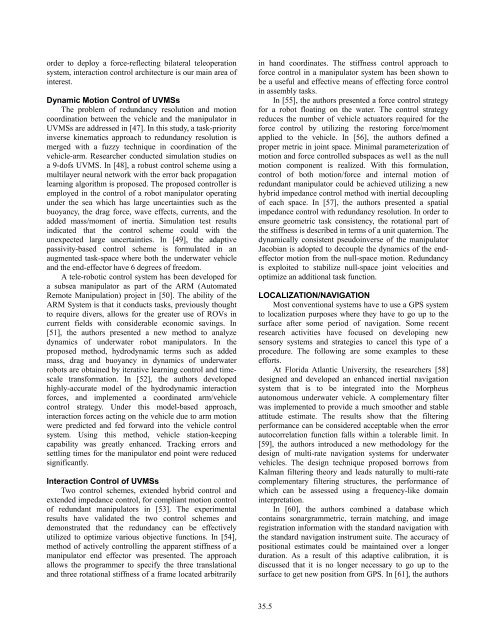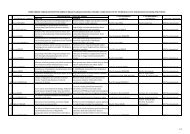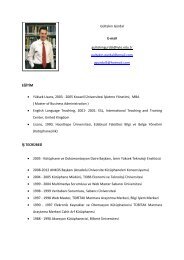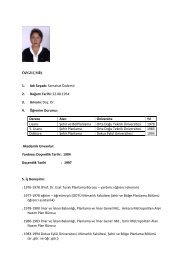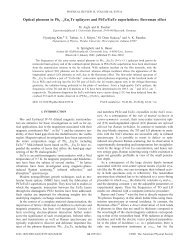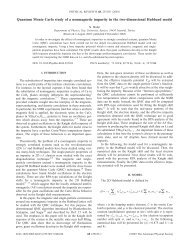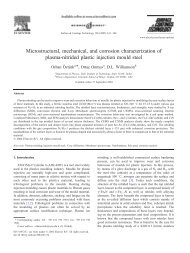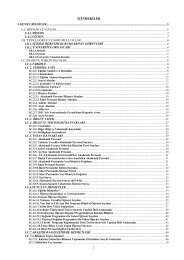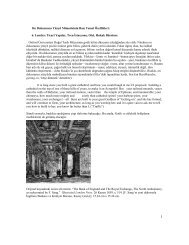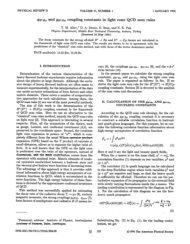A SURVEY ON UNINHABITED UNDERWATER VEHICLES (UUV)
A SURVEY ON UNINHABITED UNDERWATER VEHICLES (UUV)
A SURVEY ON UNINHABITED UNDERWATER VEHICLES (UUV)
Create successful ePaper yourself
Turn your PDF publications into a flip-book with our unique Google optimized e-Paper software.
order to deploy a force-reflecting bilateral teleoperationsystem, interaction control architecture is our main area ofinterest.Dynamic Motion Control of UVMSsThe problem of redundancy resolution and motioncoordination between the vehicle and the manipulator inUVMSs are addressed in [47]. In this study, a task-priorityinverse kinematics approach to redundancy resolution ismerged with a fuzzy technique in coordination of thevehicle-arm. Researcher conducted simulation studies ona 9-dofs UVMS. In [48], a robust control scheme using amultilayer neural network with the error back propagationlearning algorithm is proposed. The proposed controller isemployed in the control of a robot manipulator operatingunder the sea which has large uncertainties such as thebuoyancy, the drag force, wave effects, currents, and theadded mass/moment of inertia. Simulation test resultsindicated that the control scheme could with theunexpected large uncertainties. In [49], the adaptivepassivity-based control scheme is formulated in anaugmented task-space where both the underwater vehicleand the end-effector have 6 degrees of freedom.A tele-robotic control system has been developed fora subsea manipulator as part of the ARM (AutomatedRemote Manipulation) project in [50]. The ability of theARM System is that it conducts tasks, previously thoughtto require divers, allows for the greater use of ROVs incurrent fields with considerable economic savings. In[51], the authors presented a new method to analyzedynamics of underwater robot manipulators. In theproposed method, hydrodynamic terms such as addedmass, drag and buoyancy in dynamics of underwaterrobots are obtained by iterative learning control and timescaletransformation. In [52], the authors developedhighly-accurate model of the hydrodynamic interactionforces, and implemented a coordinated arm/vehiclecontrol strategy. Under this model-based approach,interaction forces acting on the vehicle due to arm motionwere predicted and fed forward into the vehicle controlsystem. Using this method, vehicle station-keepingcapability was greatly enhanced. Tracking errors andsettling times for the manipulator end point were reducedsignificantly.Interaction Control of UVMSsTwo control schemes, extended hybrid control andextended impedance control, for compliant motion controlof redundant manipulators in [53]. The experimentalresults have validated the two control schemes anddemonstrated that the redundancy can be effectivelyutilized to optimize various objective functions. In [54],method of actively controlling the apparent stiffness of amanipulator end effector was presented. The approachallows the programmer to specify the three translationaland three rotational stiffness of a frame located arbitrarilyin hand coordinates. The stiffness control approach toforce control in a manipulator system has been shown tobe a useful and effective means of effecting force controlin assembly tasks.In [55], the authors presented a force control strategyfor a robot floating on the water. The control strategyreduces the number of vehicle actuators required for theforce control by utilizing the restoring force/momentapplied to the vehicle. In [56], the authors defined aproper metric in joint space. Minimal parameterization ofmotion and force controlled subspaces as wel1 as the nullmotion component is realized. With this formulation,control of both motion/force and internal motion ofredundant manipulator could be achieved utilizing a newhybrid impedance control method with inertial decouplingof each space. In [57], the authors presented a spatialimpedance control with redundancy resolution. In order toensure geometric task consistency, the rotational part ofthe stiffness is described in terms of a unit quaternion. Thedynamically consistent pseudoinverse of the manipulatorJacobian is adopted to decouple the dynamics of the endeffectormotion from the null-space motion. Redundancyis exploited to stabilize null-space joint velocities andoptimize an additional task function.LOCALIZATI<strong>ON</strong>/NAVIGATI<strong>ON</strong>Most conventional systems have to use a GPS systemto localization purposes where they have to go up to thesurface after some period of navigation. Some recentresearch activities have focused on developing newsensory systems and strategies to cancel this type of aprocedure. The following are some examples to theseefforts.At Florida Atlantic University, the researchers [58]designed and developed an enhanced inertial navigationsystem that is to be integrated into the Morpheusautonomous underwater vehicle. A complementary filterwas implemented to provide a much smoother and stableattitude estimate. The results show that the filteringperformance can be considered acceptable when the errorautocorrelation function falls within a tolerable limit. In[59], the authors introduced a new methodology for thedesign of multi-rate navigation systems for underwatervehicles. The design technique proposed borrows fromKalman filtering theory and leads naturally to multi-ratecomplementary filtering structures, the performance ofwhich can be assessed using a frequency-like domaininterpretation.In [60], the authors combined a database whichcontains sonargrammetric, terrain matching, and imageregistration information with the standard navigation withthe standard navigation instrument suite. The accuracy ofpositional estimates could be maintained over a longerduration. As a result of this adaptive calibration, it isdiscussed that it is no longer necessary to go up to thesurface to get new position from GPS. In [61], the authors35.5


